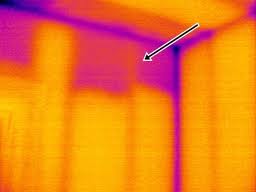In the last several years, home energy audits have gained popularity because of general awareness and The Energy Conservation Audit and Disclosure (ECAD) ordinance. This ordinance requires a home owner to disclose a homes energy performance to potential buyers.
A typical ECAD includes an inspection of the window shading, attic insulation, duct system (by a duct blaster test) and air infiltration / weatherization. While required for selling a home older than 10 years, it is not a complete audit and most likely will not find all of your weak spots. A more complete energy audit can include the ECAD and other inspections, a blower door test and/or thermal imaging.
A blower door test measures the air tightness of a building detecting leakage sites in the home. A door panel system with a calibrated fan seals an exterior door. The fan is used to blow air into or out of the building creating a pressure difference between the inside and outside. The pressure acts like natural barometric pressure and the pressure created in our homes mechanical systems which forces air through leaks in the envelope. The air flow is measured in pascal units. The higher the pascal rating, the higher the infiltration and leakage. You can use a smoke stick to visually see where your leaks are.
A duct blaster test is very similar to the blower door test. The fan is connected to the air handler, pressurized and measured to find leaks in the duct system.
An infrared camera can display heat energy as a visual image, called thermal imaging. These heat infiltrations identify where the insulation is weak or where leaks in the envelope exist. This is highly effective in illustrating to a homeowner how much of a problem exists in their home. In this thermal image, it is clear to see how the insulation has sagged at the top of the wall.

A typical energy audit cost can be from $250 – $1000 depending on the range of services.
With the results of the audit, a weatherization expert can help you seal the gaps and provide new insulation to help you save energy. Some auditors will provide post-testing and inspection to make sure weatherization has been done correctly. Some auditors will provide weatherization as part of their service.
The choice of professional can be:
BPI certified auditor by Building Performance Institute , RESNET auditor or RESNET HERS rater by Residential Energy Services Network, or an independent Auditor or Engineer.
An Energy Audit is important for new as well as existing homes. Builders who hire a HERS rater to rate a new home are providing an excellent service to their home buyers and insuring quality installations with their subcontractors. Homeowners planning to build can specify to the builder that the home be rated before they close. Any detected problems can be identified and corrected before they move in.
A special thanks to Dondi Atwell and Sean Jurica for their contribution to this information.
Dondi Atwell at ATS Engineers, HERS rater
512-748-4986
Sean Jurica PE,CEM, Energy Auditor / Weatherization
361-946-7326
Green Living Tips!
I welcome inspirations from your home to put into future newsletters. Email them to me; Cammi Klier. Thanks!!
